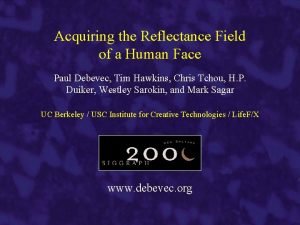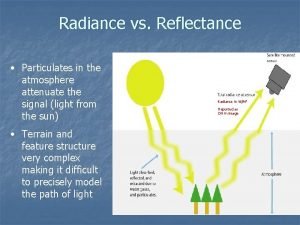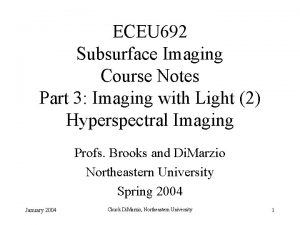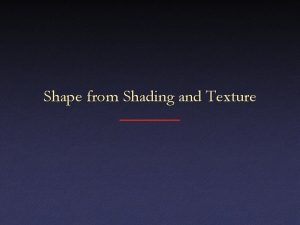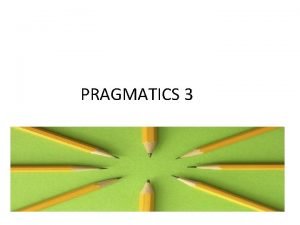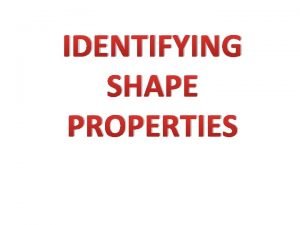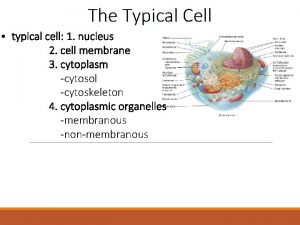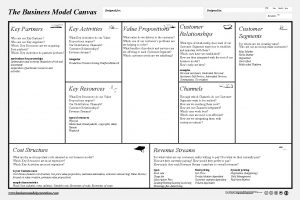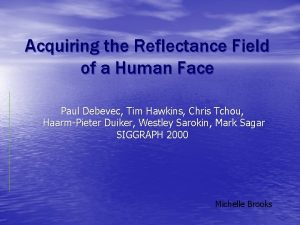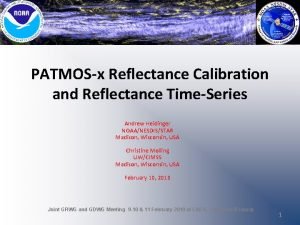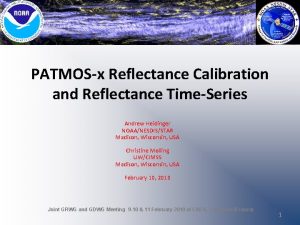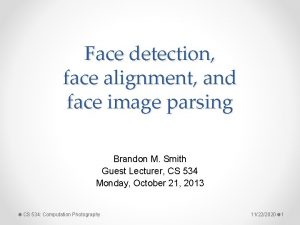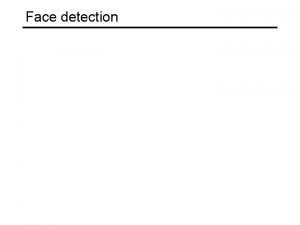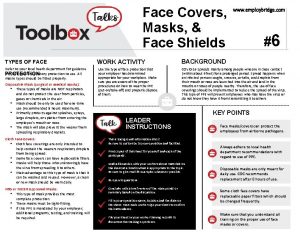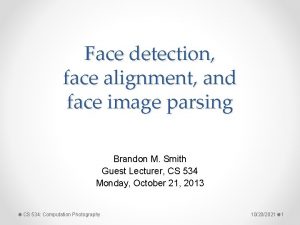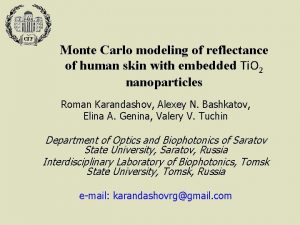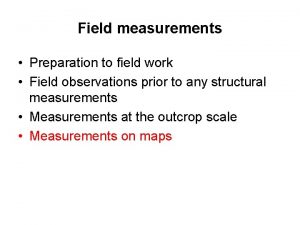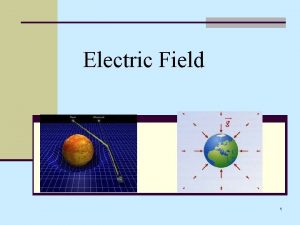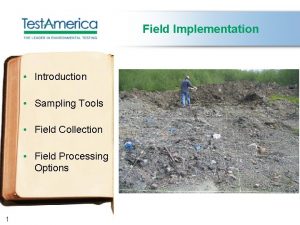Acquiring the Reflectance Field of a Human Face

































- Slides: 33

Acquiring the Reflectance Field of a Human Face Paul Debevec, Tim Hawkins, Chris Tchou, Haarm-Pieter Duiker, Westley Sarokin, Mark Sagar SIGGRAPH 2000 Michelle Brooks

Goals • To create realistic rendering of human faces • To extrapolate a complete reflectance field from the acquired data which allows the rendering of the face from novel viewpoints • To capture models of the face that can be rendered realistically under any illumination, from any angle and with any sort of expression.

Challenges • Complex and individual shape of the face • Subtle and spatially varying reflectance properties of the skin ( and a lack of method for capturing these properties) • Complex deformation of the face during movement.

Traditional Method • Texture mapping onto a geometric model of a face • Problem: Fails to look realistic under changes of lighting, viewpoint and expression

Recent Methods • Skin Reflectance has been modeled using the Monte Carlo Simulation • In early 90 s – Hanrahan and Kruger developed a parameterized model for reflection from layered surfaces due to subsurface scattering, using human skin as a model.

And now… • Reflectometry • Reflectance Field • Non-Local Reflectance Field Then… • Re-illuminating Faces • Changing the Viewpoint • Rendering

Reflectometry • Measurement of how materials reflect light – Specifically how materials transform incident illumination into radiant illumination • Four-Dimensional Bi-Directional Reflectance • Distribution Function (BRDF) of the material measured BRDFs commonly represented a parameterized functions known as reflectance models.

Reflectance Field • The light field, plenoptic function and lumigraph all describe the presence of light within space • P = (x, y, z, , )

Reflectance Field • When the user is moving within unoccluded space, the light field can be described by a 4 D function • P’ = P’(u, v, , ) • A light field parameterized in this form induces a 5 D light field in the space outside of A. • P(x, y, z, , ) = P’(u, v, , )

Reflectance Field • Radiant light field from A under every possible • incident field of illumination. 8 dimensional reflectance field function: • R = R(Ri ; Rr) = R(ui, vi, i ; ur, vr, r) • R(ui, vi, i) incident light field arriving at A • R(ur, vr, r) radiant light field leaving A

Non-Local Reflectance Fields • Incident illumination fields originates far away from A so that – Ri(ui, vi, i) = Ri(u’i, v’i, i) for all (ui, vi, u’i, v’i) • The non-local reflectance field can be represented as – R’ = R’( i, i ; ur, vr, r)

Non-Local Reflectance Fields

Re-Illuminating Faces • Goal : – to capture models of faces that cane be rendered realistically under any illumination, from any angle and with any expression. – Acquire data (Light field) – Transform each facial pixel location into a reflectance function – Render the face from the original viewpoints under any novel form of illumination

Light Stage

Light Stage • Lights are spun around axis continuously at 25 rpm • Lights are lowered along the axis by 180/32 degrees per revolution of • Cameras capture frames continuously at 30 frames/sec which yields 64 divisions of (64 x 32 size picture) and 32 divisions of in approximately 1 minute.

Constructing Reflectance Functions • For each pixel location (x, y) in each camera, that location on the face is illuminated for 64 x 32 directions of and • For each pixel a slice of the reflectance field is formed (reflectance function) Rxy( , ) corresponding to the ray through the pixel.

Reflectance Functions Cont. • If we let the pixel value of (x, y) in the image will illumination direction ( , ) be represented as: – L( , ) (x, y) then Rxy( , ) = L( , ) (x, y) • Figure: mosaic of the reflectance function for a particular viewpoint

Novel Form of Illumination • Rxy( , ) represents how much light is reflected towards the camera by pixel (x, y) as a result of the illumination from direction ( , )

Novel Form of Illumination cont.

Novel Form of Illumination cont. • Gains efficiency • No aliasing Also… • Clothing and Background changes

Clothing and Background

Changing the Viewpoint • We want to extrapolate complete reflectance fields from the reflectance field slices earlier acquired. • This allows us to render the face from arbitrary viewpoints and also under arbitrary illumination

Changing the Viewpoint • In order to render a face from a novel viewpoint, • we must resynthesize the reflectance functions to appear as they would from the new viewpoint. This is accomplished using a skin reflectance model which is used to guide the shifting and scaling of measured reflectance function values as the viewpoint changes.

Changing the Viewpoint • The resynthesis technique requires that the captured reflectance functions be decomposed into specular and diffuse (subsurface) components. • Then, a resynthesis of a reflectance function for a viewpoint is necessary • Lastly, the entire face is rendered using resynthesis reflectance functions.

Skin Reflectance • Two components : – specular – non-Lambertian

Skin Reflectance • Using RCB unit vectors to represent chromaticities the diffuse chromaticity is: (Written on board)

Separating Specular and Subsurface Components • For each pixel’s reflectance function, using a color space analysis technique • For a reflectance function RGB value Rxy( , ), R can be written as a linear combination of its diffuse color d, specular color s, and an error component.

Specular and Subsurface Components • Analysis assumes specular and diffuse colors are known. • Specular = same color as incident light • Diffuse color changes from pixel to pixel as well as within each reflectance function

Finally… • The final separated diffuse component is used to compute the surface normal n. • Also the diffuse albedo d and total specular energy ps

Transforming Reflectance Functions • To synthesize a reflectance function form a novel viewpoint, the diffuse and specular components are separately synthesized • Also a shadow map is created when synthesizing a new specular reflectance function to prevent a specular lobe from appearing in shadowed directions.

Rendering

Rendering

And Finally… • Movie on Light Stage • Demonstration
 Acquiring the reflectance field of a human face
Acquiring the reflectance field of a human face Reflectance vs radiance
Reflectance vs radiance Reflectance photometry principle
Reflectance photometry principle Reflectance spectroscopy
Reflectance spectroscopy Lambertian pattern
Lambertian pattern High considerateness style
High considerateness style Bald on-record
Bald on-record Face-to-face narrative examples
Face-to-face narrative examples 2 elements of communication
2 elements of communication Face to face interview pros and cons
Face to face interview pros and cons Positive vs negative face
Positive vs negative face Whats this shape
Whats this shape With purple fountains issuing from your veins
With purple fountains issuing from your veins Phospholipid bilayer
Phospholipid bilayer Face to face class
Face to face class Face to face ecdl
Face to face ecdl Electric field and magnetic field difference
Electric field and magnetic field difference Individual differences in second language learning
Individual differences in second language learning Field dependent vs field independent
Field dependent vs field independent Distinguish between magnetic and nonmagnetic materials
Distinguish between magnetic and nonmagnetic materials Waveguide cutoff frequency
Waveguide cutoff frequency Database field types and field properties
Database field types and field properties Field dependent and field independent
Field dependent and field independent Difference between electric field and magnetic field
Difference between electric field and magnetic field Partial reinforcement schedule
Partial reinforcement schedule Key activities
Key activities Three principles of acquiring spiritual knowledge
Three principles of acquiring spiritual knowledge Acquiring capital to implement strategies
Acquiring capital to implement strategies Strategies for acquiring it applications
Strategies for acquiring it applications Acquiring spiritual knowledge part 1
Acquiring spiritual knowledge part 1 Platt amendment significance
Platt amendment significance Acquiring new lands section 3
Acquiring new lands section 3 Key resources examples
Key resources examples What are the methods of acquiring knowledge
What are the methods of acquiring knowledge
